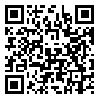Volume 72, Issue 6 (September 2014)
Tehran Univ Med J 2014, 72(6): 352-359 |
Back to browse issues page
Download citation:
BibTeX | RIS | EndNote | Medlars | ProCite | Reference Manager | RefWorks
Send citation to:



BibTeX | RIS | EndNote | Medlars | ProCite | Reference Manager | RefWorks
Send citation to:
Sadighi S, Tavaccoli A H, Dadash Poor N, Hosieny K. Production of extracellular matrix powder for tissue engineering. Tehran Univ Med J 2014; 72 (6) :352-359
URL: http://tumj.tums.ac.ir/article-1-6250-en.html
URL: http://tumj.tums.ac.ir/article-1-6250-en.html
1- Department of Internal Medicine, Cancer Research Center, Tehran University of Medical Sciences, Tehran, Iran. , ssadighi@tums.ac.ir
2- Department of Psychiatric, Tissue Bank And Research Center, Teh-ran University of Medical Scienc-es, Tehran, Iran.
3- Department of Molecular Biolo-gy, Tehran Azad University of Re-search and Sciences, Tehran, Iran.
4- Researcher of Tissue Bank Re-search Center, Tehran, Iran.
2- Department of Psychiatric, Tissue Bank And Research Center, Teh-ran University of Medical Scienc-es, Tehran, Iran.
3- Department of Molecular Biolo-gy, Tehran Azad University of Re-search and Sciences, Tehran, Iran.
4- Researcher of Tissue Bank Re-search Center, Tehran, Iran.
Abstract: (7115 Views)
Background: With the aim of regenerating healthy tissues, different tissue engineering strategies pointed to extracellular matrix (ECM)-based scaffolds in tissue engineering and regenerative medicine and wound healing. It is a multidisciplinary science works to create biocompatible scaffolds with perfect physical parameters, mechanical integrity and high porosity to promote cell growth, migration and angiogenesis. With the increased incidence of obesity, subcutaneous adipose tissue is abundant and readily accessible. Liposuction surgeries yield from 100 mL to 3 L of lipoaspirate tissue.
We present our prepared acellular ECM powders derived from human adipose tissue obtained from lipoaspirate, which contains large amounts of collagen suitable for induction of adipogenesis.
Methods: The study had been carried out from December 2012 to March 2013 in Tissue Bank and Research Center in Imam Khomeini Hospital Tehran, Iran. Fresh human adipose tissue was obtained by liposuction of abdominal fat pad in a private Day Clinic. By using wasted material of liposuction, we obtained 100 to 200 cc fat tissue from each patient. After physical (freeze-thaw-slicing-manual massage) and chemical (enzymatic-detergent-acid digestion) treatment, an acellularized matrix was created from fat tissue. The final material lyophilized and ground to powder. We analyzed ultra structure and biochemical properties of obtained ECM powder by using electron microscopy, immunohistochemistry (IHC) examination and proteomic studies.
Results: After mechanical and chemical process of decellularization, scanning electron micrographs of the samples showed smooth and contiguous collagenous components throughout the scaffold. IHC showed strong positive labeling for collagen IV and no evidence of nuclear material in the specimen.
Separation of protein complex by Blue Native Polyacrylamide gel electrophoresis (BN-PAGE) has proven type I collagen triple helices associate to form banded fibrils. RNA preparation and Gene Expression Analysis (RT-PCR) by using specific primers for laminin, fibronectin, collagen type I and IV, desmin, and actin showed strong staining of our fat tissue scaffold with collagen type I, fibronectin, collagen IV and laminin.
Conclusion: The results show that our decellularization method produced an adipose ECM scaffold rich of collagen fibers, suitable and effective substrate for use in soft tissue engineering and regenerative medicine.
Type of Study: Original Article |
Send email to the article author
| Rights and permissions | |
 |
This work is licensed under a Creative Commons Attribution-NonCommercial 4.0 International License. |





